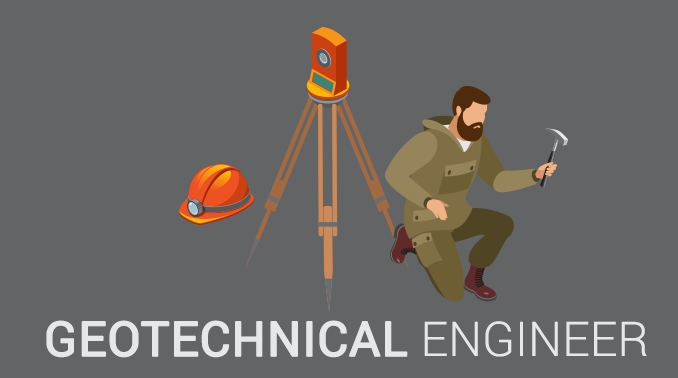Geotheta Can Be Fun For Anyone
Geotheta Can Be Fun For Anyone
Blog Article
Not known Facts About Geotheta
Table of ContentsMore About GeothetaThe 30-Second Trick For GeothetaNot known Details About Geotheta Examine This Report on Geotheta5 Easy Facts About Geotheta Explained

They perform site investigations, accumulate samples, carry out lab examinations, and analyze data to examine the suitability of the ground for building jobs - Consulting Engineers. Based on their findings, geotechnical designers supply suggestions for foundation layout, slope stability, preserving structures, and reduction of geotechnical threats. They work together with other experts, such as designers, architectural designers, and building and construction groups, to make sure that geotechnical factors to consider are incorporated right into the general task style and execution
By analyzing the behavior and buildings of soil and rock, they can identify prospective geotechnical threats such as landslides, soil settlement, or incline instability. Their proficiency aids avoid failings or mishaps that could endanger lives and home. Right here are some in-depth responsibilities and responsibilities of a geotechnical designer: Site Examination: Geotechnical designers conduct site investigations to collect information on subsurface problems.
They translate the information to recognize the properties and habits of the dirt and rock, including their toughness, permeability, compaction attributes, and groundwater problems. Geotechnical Evaluation and Style: Geotechnical engineers assess the information collected during site examinations to evaluate the stability and suitability of the website for construction jobs. They perform geotechnical estimations and modeling to review variables such as bearing capability, settlement, incline stability, side planet stress, and groundwater circulation.
Geotheta Can Be Fun For Anyone
Foundation Design: Geotechnical engineers play a vital role in designing foundations that can safely sustain the designated framework. They analyze the soil conditions and tons demands to establish the appropriate structure type, such as superficial structures (e.g., footings), deep structures (e.g (https://geotheta.blog.ss-blog.jp/2024-08-02?1722614750)., stacks), or specialized techniques like dirt renovation. They consider variables such as settlement limits, bearing ability, and soil-structure interaction to create optimum structure layouts
They assess building strategies, screen website activities, and carry out field assessments to verify that the layout referrals are adhered to. If unanticipated geotechnical issues develop, they evaluate the scenario and provide recommendations for removal or changes to the design. Risk Assessment and Reduction: Geotechnical designers examine geotechnical threats and dangers connected with the job site, such as landslides, liquefaction, or dirt disintegration.

Collaboration and Communication: Geotechnical engineers work very closely with other specialists entailed in a project, such as designers, structural engineers, and building and construction groups. Efficient communication and collaboration are necessary to integrate geotechnical factors to consider into the general project style and construction process. Geotechnical engineers provide technological knowledge, response queries, and make certain that geotechnical requirements are fulfilled.
What Does Geotheta Mean?
Below are some kinds of geotechnical designers: Foundation Engineer: Foundation designers focus on creating and examining structures for structures. They analyze the dirt problems, load needs, and site attributes to figure out one of the most ideal structure kind and style, such as shallow foundations, deep foundations, or specialized techniques like stack foundations.
They examine the elements influencing incline stability, such as dirt properties, groundwater conditions, and slope geometry, and establish techniques to avoid incline failings and alleviate dangers. Earthquake Designer: Earthquake engineers focus on assessing and developing frameworks to stand up to seismic forces. They assess the seismic threat of a website, assess soil liquefaction possibility, and establish seismic style criteria to ensure the security and strength of frameworks throughout earthquakes.
They carry out area screening, accumulate examples, and examine the collected information to define the soil homes, geologic formations, and groundwater problems at a website. Geotechnical Instrumentation Engineer: Geotechnical instrumentation engineers concentrate on tracking and measuring the actions of soil, rock, and structures. They install and keep instrumentation systems that keep track of elements such as dirt settlement, groundwater degrees, slope movements, and architectural displacements to examine efficiency and give very early warnings of potential problems.
Geotheta Can Be Fun For Everyone
They conduct examinations such as triaxial examinations, combination tests, straight shear examinations, and leaks in the structure examinations to collect information for geotechnical evaluation and style. Geosynthetics Engineer: Geosynthetics designers concentrate on the style and application of geosynthetic materials, such as geotextiles, geogrids, and geomembranes. They make use of these products to enhance dirt security, reinforce inclines, offer drain options, and control disintegration.
They tend to be investigative people, which indicates they're intellectual, introspective, and analytical. They wonder, methodical, logical, analytical, and rational. A few of them are also social, implying they're kind, charitable, participating, person, caring, useful, understanding, tactful, and friendly. Does this noise like you? Take our free profession test to discover if geotechnical designer is among your top profession suits.
In the workplace setting, geotechnical designers use specialized software application tools to execute calculations, create layouts, and assess information. They prepare records, review project specs, interact with customers and employee, and coordinate project tasks. The office setup provides a conducive setting for study, evaluation, and partnership with various other professionals associated with the project.
3 Easy Facts About Geotheta Described
They frequently go to job sites to perform website examinations, evaluate geotechnical conditions, and gather data for analysis. These visits include traveling to various locations, occasionally in remote or difficult terrains. Geotechnical designers might carry out dirt tasting, conduct examinations, and monitor construction tasks to make certain that the geotechnical aspects of the project are being executed properly.
Geotechnical engineers also operate in specialized geotechnical labs. In these facilities, they carry out experiments, perform examinations on soil and rock samples, and evaluate the design residential properties of the materials. Geotechnical lab designers work thoroughly in these environments, dealing with testing devices, operating instruments, and videotaping data. They collaborate with various other research laboratory personnel to make sure accurate and trusted screening outcomes.
Report this page